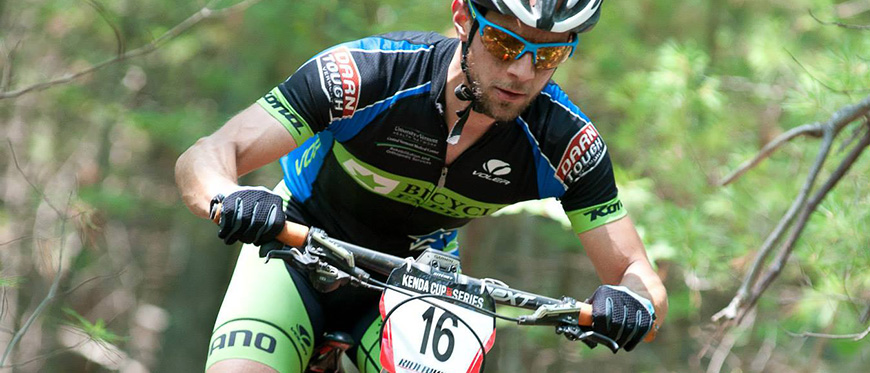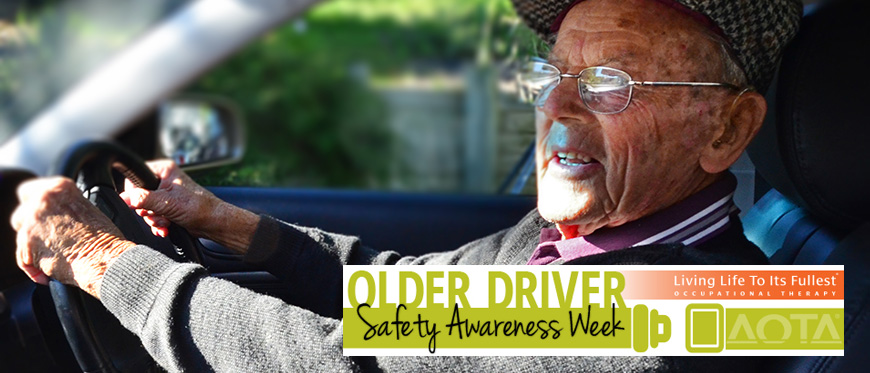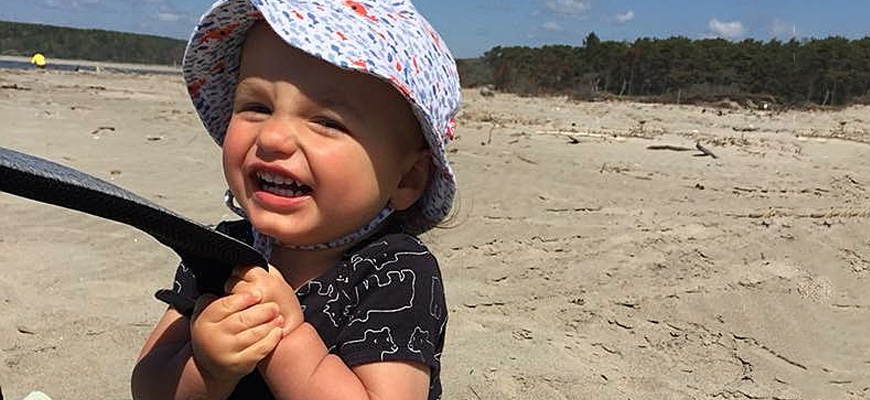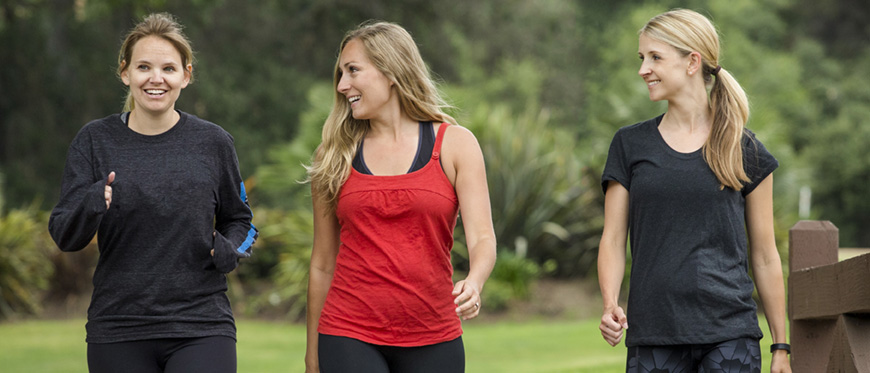After a long winter, it is always exciting to take that first ride in the spring and start thinking about all of your favorite rides and maybe new routes or trails that you want to explore. There is nothing worse than having nagging injuries start popping up that plague your rides, or worse, prevent you from riding at all. To help you stay healthy and injury-free, we've pulled together a list of some key strengthening exercises.
 Helping us out are Team Bicycle Express members Greg Jancaitis (shown above), Elisa Otter and Ezra Tautfest. Team Bicycle Express Racing is Vermont’s first professional and grassroots mountain bike team. Bicycle Express Racing partners with local and national companies and is focused on using competitive cycling to inspire a healthier community and to promote unique brands. They strive to grow the sport of cycling in Vermont and New England, by providing structure, growth and resources to racers so they can compete in local and international events.
Helping us out are Team Bicycle Express members Greg Jancaitis (shown above), Elisa Otter and Ezra Tautfest. Team Bicycle Express Racing is Vermont’s first professional and grassroots mountain bike team. Bicycle Express Racing partners with local and national companies and is focused on using competitive cycling to inspire a healthier community and to promote unique brands. They strive to grow the sport of cycling in Vermont and New England, by providing structure, growth and resources to racers so they can compete in local and international events.
Important Exercises for Cycling Strength and Conditioning

Crunch
A great alternative to the traditional sit-up, this exercise targets abdominal muscles – both external and internal and the hip flexors. Conditioning these build general strength and stability on the bike helping with form and fluidity in and out of the saddle.
Instructions: With knees bent up and feet flat, hands behind head, curl your trunk up until shoulders are off the ground then come back down. Do until fatigue.
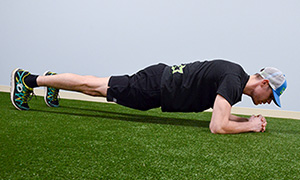
Plank
Planks are one of the best all-round movements that a bike rider can do. The core needs to be stable while riding and help support you as you move your legs and sometimes your arms. This is a great way to get a stable base by strengthening your abdominal and back muscles.
Instructions: Keep glutes engaged and lower back flat. Look straight down to keep your head and neck in line with your trunk. Push the floor away with your arms to engage your mid back muscles/ The plank should be held as long as good form can be maintained. A good goal is 1-2 minutes.

Side Plank
The side plank focuses more on the obliques and quadratus lumborum that are on the side of your trunk, but also the same muscles that the plank works on as well.
Instructions: With feet stacked raise body up onto forearm, making sure you are lined up well - keeping elbow and both shoulders lined up vertically and keeping the body in a straight line. Do until you fatigue in your side. Repeat on other side. To make it more advanced, lift top leg up and hold.
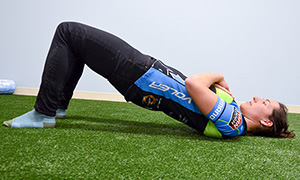
Bridge/Glute Max
Bridges work muscles from your back, abdominals, glutes, hamstrings, and quads, so it focuses on a big area. This is also great for cyclist because it helps strengthening outside of the bent over position that a cyclist is usually in by helping to extend the hips.
Instructions: Lying on your back with your knees bent, squeeze your buttocks, press through your heels and lift your hips into the air. You should form a straight line from your shoulders to your knees. Lower your hips slowly and repeat 20-30 times. Your buttock muscles should tire.
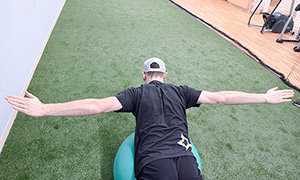
Midback
Strengthening the muscles between the shoulder blades and stretching the muscles of the chest can help to maintain good upper body and spinal posture and decrease strain on your neck and shoulders.
Instructions: Lying on your stomach, squeeze your shoulder blades together to lift your arms up and out to the side so they are even with your body. Then lower slowly. You should feel the muscles between your shoulder blades working. Repeat 20-30 times. Exercise can be done on ball or floor.
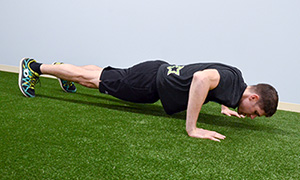
Push Up
This is called a compound movement because it targets multiple muscle groups. It’s a great all round exercise for cyclists and focuses on the sometimes neglected upper body. It also benefits the whole core.
Instructions: Start on your toes with palms out to the side on ground. Push up until elbows lock out, then lower yourself toward the ground then back up. Keep your body in a straight line as you do this, and do until you fatigue in your arms/chest.
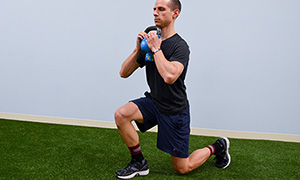
Lunge
This exercise targets many of the most important pedaling muscles. It also works the core muscles, which are vital for maintaining good form on the bike.
Instructions: Take a big step forward, then allow back knee to dip down toward the ground – don’t let your front knee go past your toes. Come back up as you take a step forward and complete another lunge with other leg forward. Continue to alternate until you fatigue in your legs. You can hold onto a weight, such as a kettlebell to make more difficult.
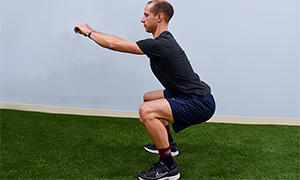
Squat
If you’re only going to do one movement, do this one. The squat is power exercise for cyclists and perhaps the corner stone of your strength regime.
Instructions: Standing with feet shoulder width apart, reach back with your hips, then bend your knees into a sitting position while keeping your chest up. Holding your arms out in front of you will help to counterbalance for hips traveling backward. Your weight should be in your heels as your hips reach back and as you sit into the squat. You should push through your heels stand.
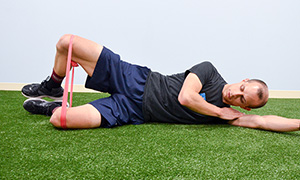
Clam Shell/Glute Med
The gluteus medius on the outside of your pelvis provides for efficient power generation during the pedal stroke by creating stable, strong hips and stabilizing the pelvis.
Instructions: Lie on your side with your knees bent. Squeeze your buttock muscles and lift your top knee up without your hips rolling backward. Then lower your knee slowly. You should feel your buttock muscles working. Use band to add resistance and increase difficulty. Repeat 20-30 times on each side.
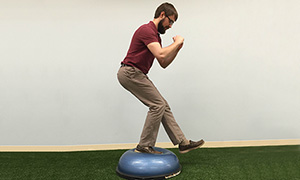
Bosu Ball Single Leg Squat
This is a great exercise for all those stability muscles in your leg. Other devices, such as a wobble board, balance board, balance cushion or pillow could also be used for the same purpose. This is a higher level exercise and should not be performed unless it is comfortable.
Instructions: Step onto the center of the Bosu ball with your right foot. Bend your left knee behind you. Balancing, bend your right knee until 90-degrees and stand back up. Ensure that your knee stays behind your toes and try to keep your knee over the middle of your foot as much as possible.

